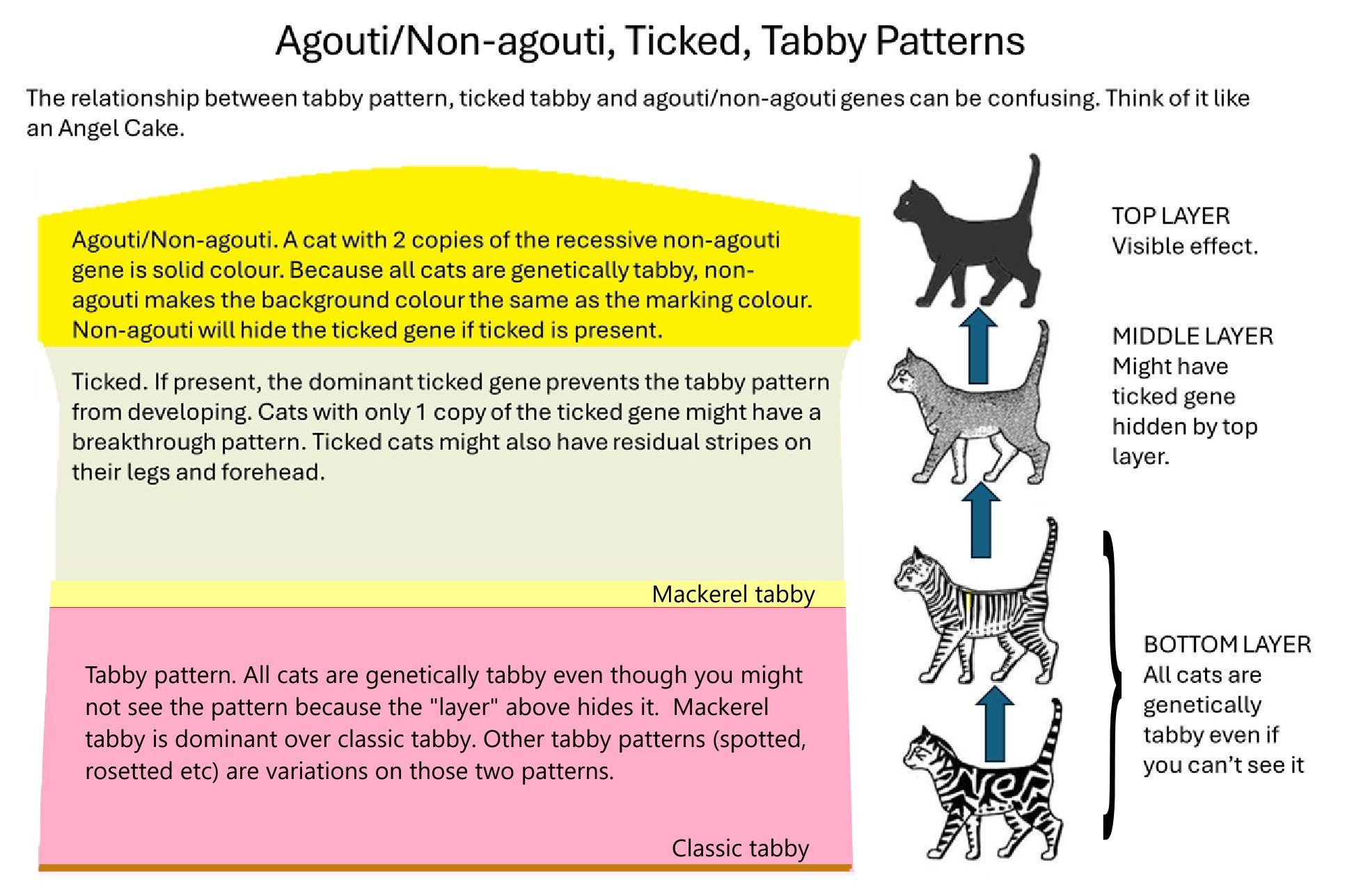
STRIPED, SPOTTED AND TICKED CATS
For most people, two of the most familiar "types" of cat are the "blotched tabby" and the "ginger tom" (or "marmalade cat"). These are two examples of tabby, or striped, cat. In the early days of cat exhibitions, tabbies were divided into banded and spotted. Their name was said to have been derived from a street in Baghdad celebrated for the manufacture of its watered or moire silks. When sold in England, this silk was called atabi or - by those who misheard - taffety.

The cat fancy recognises four basic types of tabby (ticked, mackerel, classic, spotted) with breed-specific variations on each of these types. For example the "marbled tabby" seen in Bengals is a variation on the "classic tabby". Nature isn't so restricted in its patterns and there are numerous variations found in random-bred cats and emerging breeds (particuarly those with hybrid ancestry) that aren't recognised by the cat fancy. So as well as the cat fancy definitions, I've covered as many variations as I can and there are no doubt many more out there!
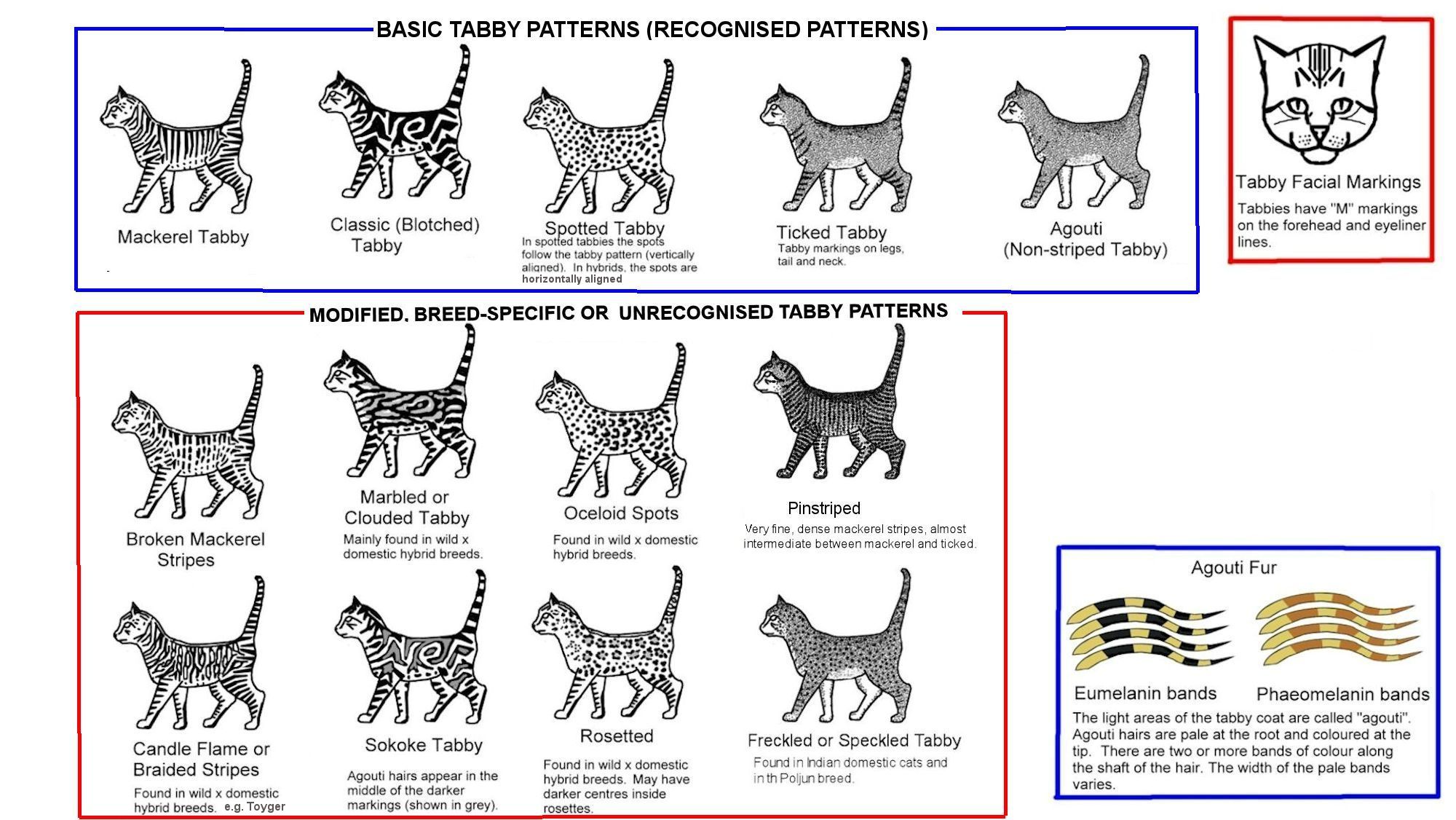
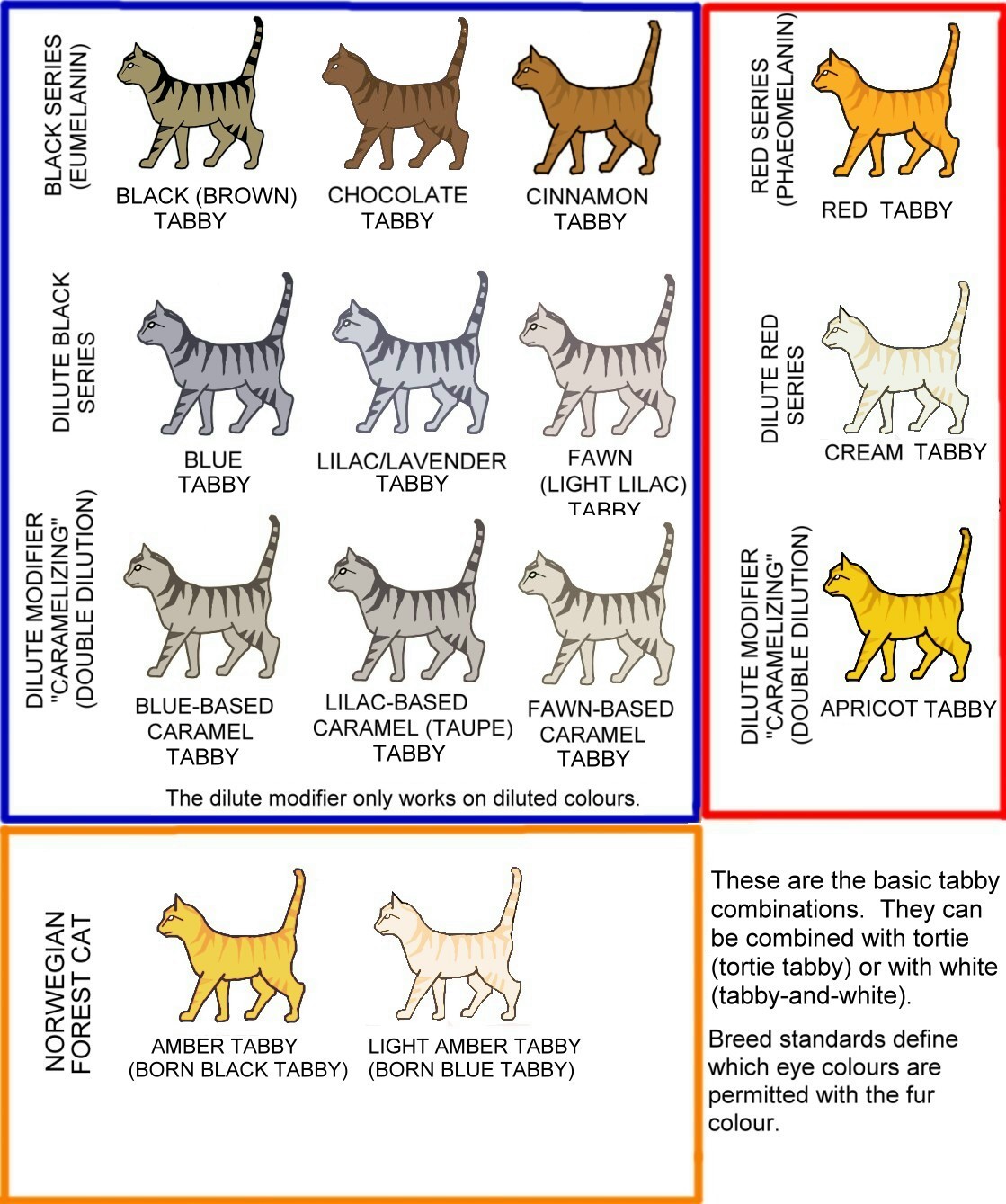
MACKEREL AND BLOTCHED TABBIES
The two most common tabby patterns are "mackerel tabby" and "classic tabby" (blotched tabby, oyster tabby). These two patterns are common in random-breeding pet and feral populations. In the mackerel tabby, the vertical stripes are thin like fishbones and may break up into bars or vertically aligned spots. In the "classic tabby" (blotched tabby) there are broad bands, whorls and spirals of dark colour on a paler background usually with a "bulls eye" (or "oyster") pattern on the flank. Sometimes the markings are extremely broad and fuse together, especially on the back and flanks. Viewed from above, the classic tabby pattern resembles butterfly wings, giving it the nickname "Butterfly Tabby" - a term better known in grandmother's day than in the modern day. The mackerel pattern is dominant to the classic pattern, but it's the classic pattern that became established early on at cat shows because the bolder, thicker markings were more eye-catching, especially on a silver background.
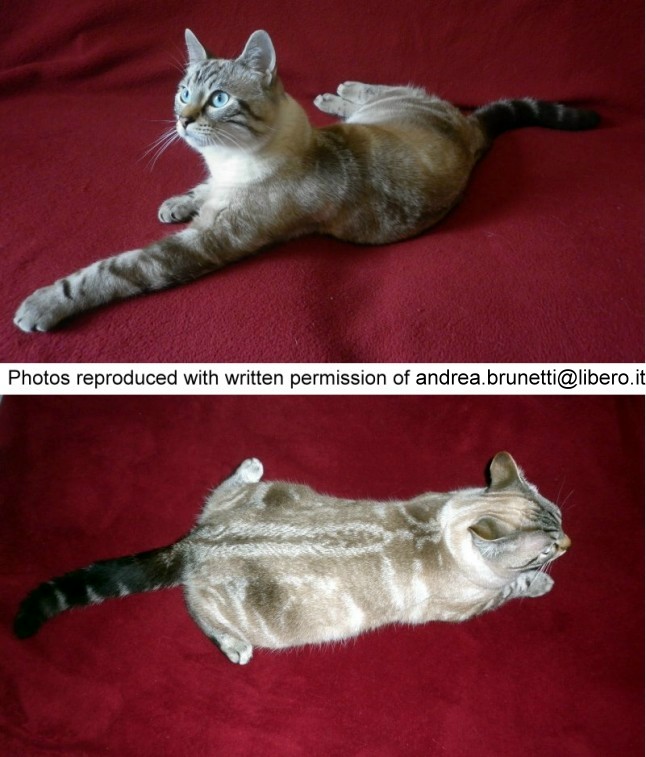
Andrea and Beata Brunetti, in Italy, have a pedigree Thai (the European name for the less extreme, traditional or old style of Siamese cat) called Urban Hunter with a visible blotched tabby pattern and an interesting dorsal stripe as shown above. Urban Hunter has been mated to a red-point Thai called Kasia Ruda, resulting in one male and four female kittens. All of these have dorsal stripes similar to Hunter. In some lines of old type Siamese, there is less contrast between body and points, allowing the underlying pattern to show through (in spite of the low contrast and aqua-blue eyes, Hunter does not have Tonkinese ancestry). Dorsal striping in tabbies is very variable and in this instance has combined with the low-contrast Siamese pattern to give an even more distinctive appearance.
Both the mackerel tabby and the classic tabby have stripes and bars on the legs and tail and the classic "M" (or fleur-de-lys) marking on the forehead and the belly is usually spotted. The background colour is an agouti pattern, meaning that each individual hair has several bands of colour along its length. The foreground colour is the solid colour (non-agouti) of the markings. The tabby pattern occurs in various colours where the markings are a darker version of the background colour. There are also versions where the markings occur on a silvery (grey) background colour. It can also be mixed with the tortoiseshell pattern to produced torbies or patched tabbies. In Britain, the classic brown/black tabby is most common especially in towns, to the point of being considered the quintessential "British Cat". Because the classic pattern is recessive to mackerel tabby, classic tabbies breed true for that pattern. Their bold blotched markings are considered to be more attractive or desirable than the mackerel tabby. Meanwhile, the typical Australian domestic pattern is described as neither truly spotted nor striped, but having a pattern broken into bars. This can be seen in feral cats which have reverted to a wilder-looking mackerel tabby pattern that may offer them better camouflage. Meanwhile, in the California Toyger breed, the mackerel tabby pattern has been selectively refined into a more tiger-like pattern of thin but solid stripes (sometimes called candle-flames) which do not break up, while in red self Persians, the classic tabby pattern has been refined to coalesce and to mask the background colour as far as possible in order to create the illusion of a "solid red" cat.
|
|
|
|
|
|
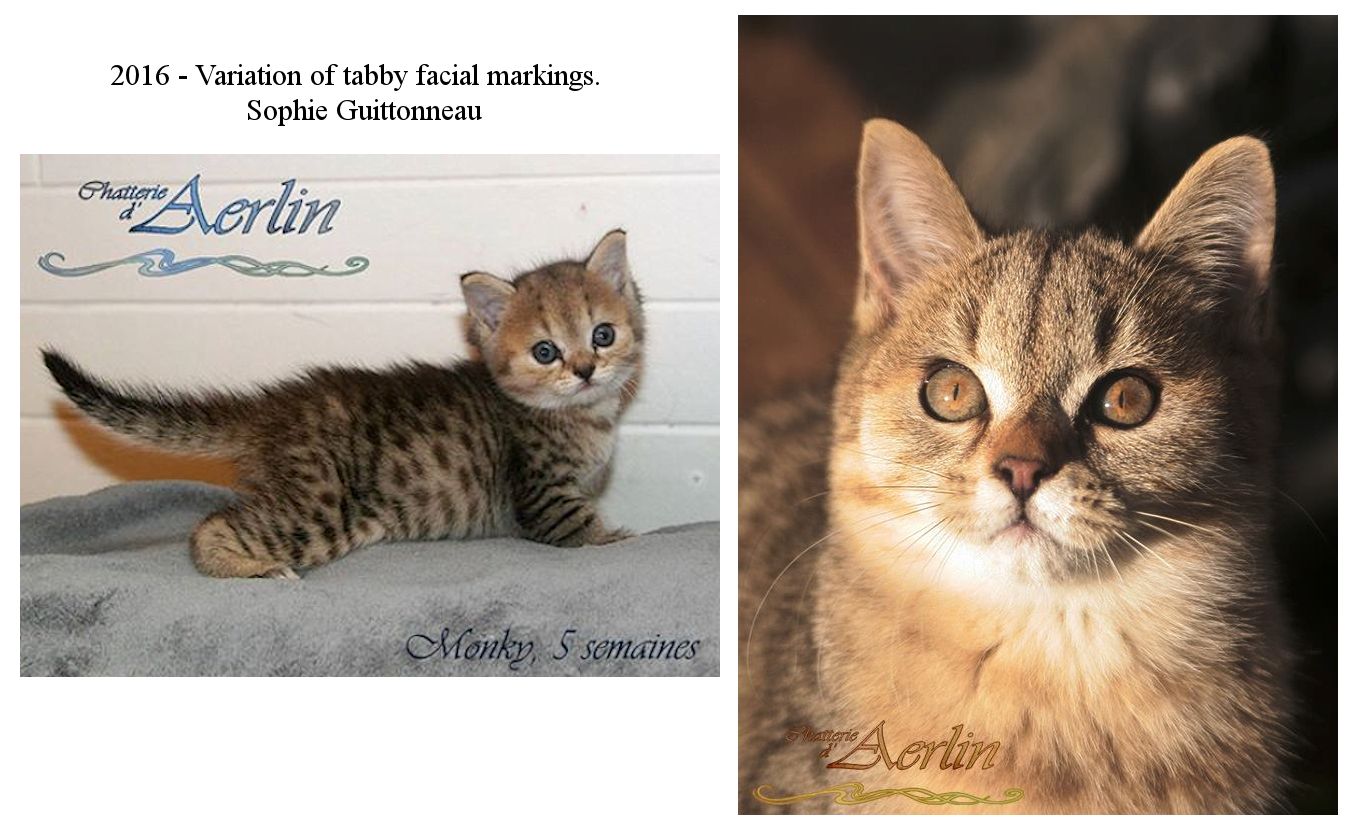
In the Toyger breed, the ideal pattern is a modified mackerel pattern sometimes described as "candle-flame" or braided based on its appearance. This mimics the pattern found in tigers. Ideally the stripes should be evenly spaced and close to each other. Rather than break up into spots, they should break up into elongated hollow stripes or braids.
|
|
The gene for the ticked tabby (Abyssinian) pattern is on a different locus to the classic/mackerel tabby pattern gene. When two copies of the ticked tabby gene are present it completely masks the other patterns. If a cat inherits only one copy of the ticked tabby gene, the masked pattern sometimes appears to break through (this is based on observation and a knowledge of the parents' patterns). Below are some ticked tabbies where an underlying pattern is visible.
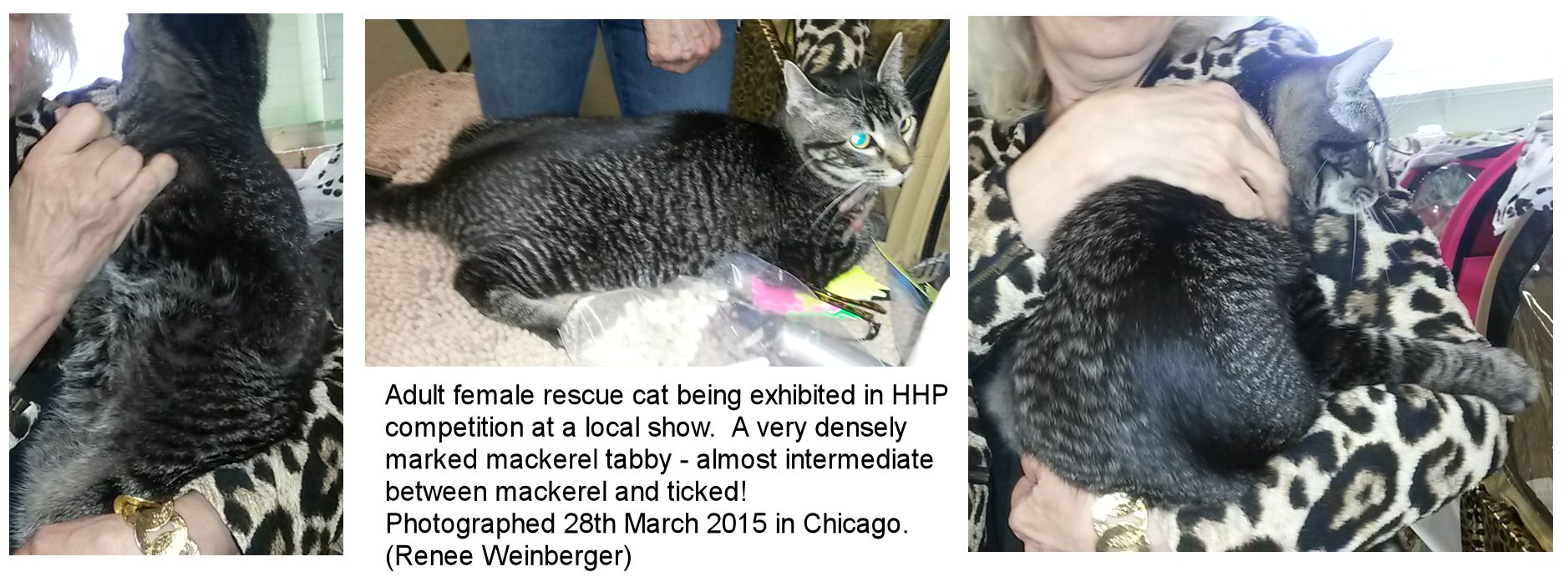 |
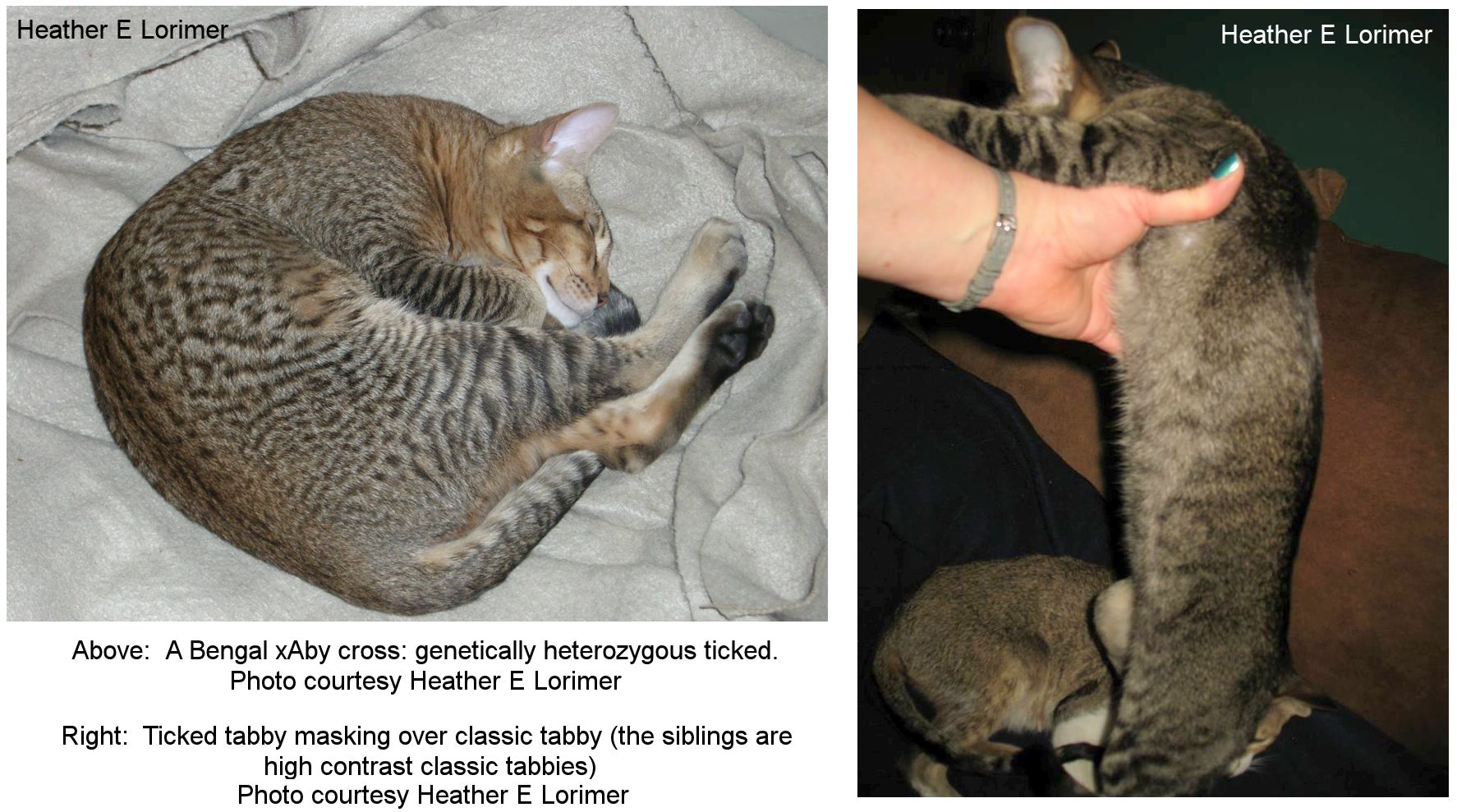 |
For Charcoal Tabby - a modified pattern, see Hybrid Hues - Colours introduced from Wild Cats
TICKED TABBIES (UNPATTERNED TABBY)
The third tabby pattern is the "ticked". This is due to another gene which masks any other tabby pattern. It is seen in the Abyssinian and Somali breeds, the Singapura and the Asian and sometimes in random-breeding cats. There is almost no striping except possibly for thin stripes on the legs, face and tail. Instead, only the agouti pattern can be seen, giving a "ticked" effect.
The Abyssinian breed was also known as the Ethiopian and the Algerian and was believed to trace back to the Egyptian Middle Kingdom. Its agouti fur resembles that of the African wildcat, an ancestor of modern cats. The first documented "Abyssinian" was "Zula", brought back from Abyssinia (Ethiopia) in 1868. A stuffed Abyssinian (possibly also from Ethiopia) resides at Leiden University's Natural History Museum (Netherlands) and dates to between 1833 and 1882. Apart from that, there is little evidence of Ethiopian origins. Ticked tabbies occur in India and Ceylon (Sri Lanka) and might have been imported from there (perhaps by British governors of India). Frances Simpson described it as a "small cat of delicate colouring", a description now more appropriate to the Celonese or Singapura. Ticked cats also occured naturally in Britain and the Abyssinian breed might have been selectively bred from these. The rabbit-like agouti colouring led to early ticked cats being called Bunny Cat, Hare Cat, Rabbit Cat or Cunny (the latter somewhat naively - this being the slang term for female genitalia!). The most popular was known as the British Ticked and perhaps deserves to be recreated as a variety of British Shorthair.
H C Brooke (writing in Frances Simpson's "The Book of the Cat") wrote in the section on "Some Foreign Cats" of the Egyptian or Caffre Cat and identified it as "the progenitor of the majority of the domestic cats [ ] it is found over the whole of Africa, and it is quite easy to understand how, with its eminently tameable disposition, it gradually spread over Europe. Our so-called Abyssinian cats [ ] bear a very striking resemblance to this handsome variety of cat." Similar ticked cats came from India were they were believed to have been derived from the Jungle cat (F chaus) while spotted varieties supposedly derived from the Leopard cat, Desert cat and Rusty Spotted cat. Brooke's own wife owned an "Indian cat" and Brooke wrote, "Very curious and handsome is the Indian cat 'Indischer Fürst' exhibited by Mrs H C Brooke. His most striking peculiarities are the length and slenderness of his limbs, the extreme shortness of his coat, and his thin and tapering tail [ ] His ears are small, but as a kitten they were of enormous size, and with his long and pointed head gave him a most weird experience. The voice of this cat is very variable, and far more resembles the raucous call of the Siamese than the voice of any European cat." This cat, and his sister, were apparently stolen from a hotel in Bombay by an English sailor. He was given to a shoemaker in Leytonstone and later sold to Mrs Brooke for a considerable sum plus part-exchange of a kitten with seven toes on each of its paws (these being lucky mascots for sailors). In retrospect it seems that the cat was probably an Oriental (of the older style), but in Brooke's times only the Siamese was known. The Siamese of that time being far less extreme than the modern variety; the illustration shows the Indian cat as similar to an Abyssinian.
"A very taking variety is the Abyssinian. A good specimen should very strongly resemble what one might well expect the Egyptian cat to become after generations of domestication. [ ] The colour of an Abyssinian should be a sort of reddish-fawn, each individual hair being 'ticked' like that of a wild rabbit - hence the popular name of 'bunny cat. The great difficulty in breeding these cats is their tendency to come too dark and too heavily striped on the limbs; the face should be rather long, the tail short and thick and the ears large. [ ] The Abyssinian should not be a large coarse cat. A small cat of delicate colouring and with the above-mentioned body properties is by far to be preferred to the large, coarse, dark specimens one sees winning under some all-round judges because of their size."
Breeders favoured the lighter coloured cats as these showed off the ticked pattern to better effect. However, some judges favoured very dark, almost sooty Abyssinians over better marked fairer specimens, penalising the latter because of a "dozen white hairs on the throat". However, some of the earliest Abyssinians in England were Silver Abyssinians and 1889, Harrison Weir's 1889 standard for the Abyssinian accommodated these: "The Abyssinian Silver Grey or Chinchilla is the same in all points, with the exception of the ground colour being silver instead of brown. This is a new and beautiful variety. However, the opinions of early cat fanciers were firmly divided into those who liked the silvers and those who despised them. Brooke was opposed to them and in 1903 marked one down with the comment "It is a ticked cat but not the proper Abyssinian colour." Elsewhere, Brooke wrote "I regard silver as an absolute alien colour to the breed, and though there would have been no harm done if these silvers had been kept to themselves, I cannot but think that they did an infinity of harm to the breed, by introducing a grey tinge into the coat, with the result that the beautiful "ruddy" tinge which we used to see in the cats of long ago, is now apparently lost to us. How they originated, or whether any cross was made use of to obtain them, I do not know." A few years later, in 1908, W Johnson Wood commented that "the silver specimens are even nicer than the brown". (Silver Abyssinians remained and are popular in Britain, though less so in the USA)
A strain of apparently albinistic Abyssinians had been bred by Sir William Cooke, of Newbury, but in 1927, his last male died, thus ending a very remarkable strain of albinistic Abyssinians. HC Brooke noted that a lady in Yorkshire owned a pair, but had never shown them and that she was contemplating having the male neutered. It was suggested that the strain derived from a cross with Siamese cat, but Sir William was confident that this was not the case and that the colouration did not bear out this theory. These cats were creamy white, with rabbit-coloured fur on their ears and an "eelstripe" or dorsal line down the back. Their eyes were blue suggesting a form of albinism. At around the same time, another mutation of Abyssinian was reported from Vienna by Herr Lesti. In his second litter by Ras Tafari, one kitten was fawn with a pinkish tint, though the previous litter had all resembled their sire.
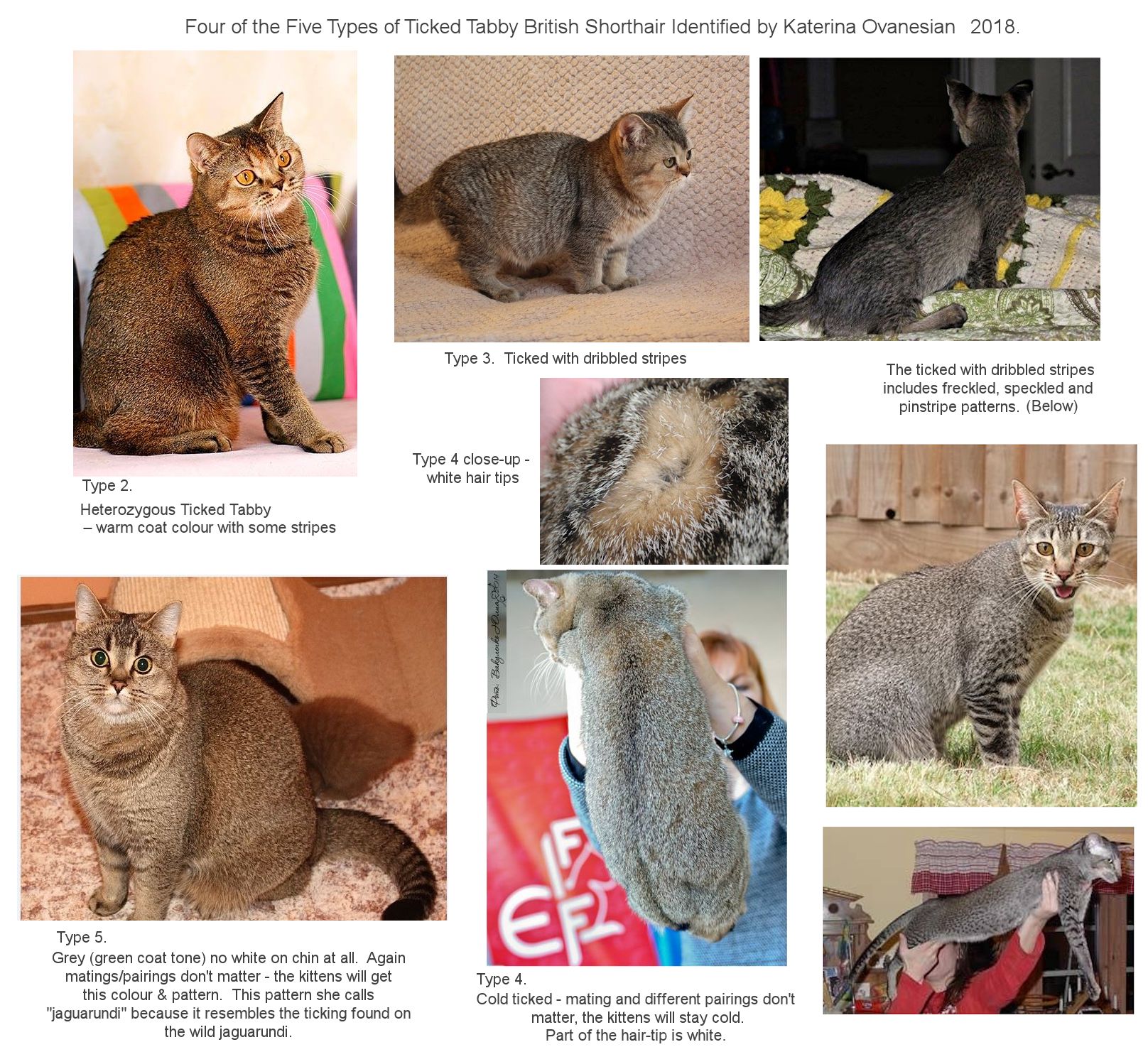
Katerina Ovanesian in Ukraine has been investigating the ticked tabby pattern in British Shorthairs. In August 2018, these cats are now 12 generations away from Somali, and she notes that these variations are not seen in the Somali and must come from interactions with the British Shorthair s genes. She has identified 5 variations and their inheritance according to British Shorthair breeding:
Type 1 - Homozygous Ticked Tabby the Abyssinian pattern
Type 2 - Heterozygous Ticked Tabby warm coat colour with some stripes
Type 3 Ticked with dribbled stripes pinstripes, speckles or freckles (breakthrough of the masked tabby pattern).
Type 4 Cold ticked, where the hair tip is white. This is inherited by the kittens (i.e. appears dominant).
Type 5 Jaguarundi or green where there is no white on the chin and where the coat is grey/green toned. This is inherited by the kittens (i.e. appears dominant).
In random-bred tabbies, the number, width and placement of bands on hairs in the agouti areas varies from cat to cat. While the Agouti gene permits the hairs to have bands of colour, there are probably minor genes which influence the way in which the hair is banded. Further polygenes may reduce or remove residual leg-barring, tail markings and facial markings on ticked tabbies. Hence the showbench Abyssinian has far fewer markings than ticked tabbies in the random breeding population.
|
Demonstrating that the ticked tabby pattern can occur in the random breeding population; this British semi-feral cat has ticked fur in a cream colour with some tail rings and a darker cream face with very few facial markings. He does not have leg stripes or necklace markings. | |
|
| |
It is possible to introduce the ticked tabby pattern into other breeds. For example red ticked tabby could be introduced into the Persian breed to create a red self (solid) Persian which has no tabby markings. It would be interesting to see the effect of ticked fur on the full-length Persian coat, though there seems to be little interest in this. All red self Persians display the red tabby pattern to some extent, a red ticked tabby would appear almost solid colour.
The Abyssinian was recognised in the 1860s but the pattern itself is far older. It is the "wild type" of tabby pattern and there have even been suggestions that it is related to the ticked pattern of the Jungle cat (F chaus) which may have interbred with domestic cats at an early stage of their evolution. Recent crosses with the jungle cat have introduced a striking new variation of the ticked pattern - the silver tipped black -into the domestic gene pool. The Somali is a longhaired version of the Abyssinian. Long hair is a recessive gene and can be carried hidden by cats, resurfacing when two carriers meet and produce offspring. The Somali was recognised in 1967 though longhaired Abyssinians had been cropping up from time to time before that, much to the embarrassment of breeders who regarded it as a sign of impurity in the bloodlines. In CFA and GCCF, the Somali is a standalone breed (CFA 1979, GCCF 1991). Due to the small gene pool, outcrosses are made to Abyssinians and the shorthaired Abyssinian x Somali progeny are registered as Somali (or Somali variant) in these associations. They are not registered as Abyssinian because they carry the recessive longhair gene. Some other registries allow the breeds to be crossed and the progeny registered according to hair length. In contrast, FIFe in Europe (and many European registries) register the shorthaired Aby/Somali offspring as Abyssinian. Hence registries that strictly segregate the breeds may require an 8-generation pedigree to prove that an Abyssinian being transferred from another registry has no Aby/Somali crosses in its ancestry. This is not foolproof as there could still be longhaired carriers. In the Canadian Cat Association (CCA), cats with Aby/Somali ancestry are registered as either Longhair Somali or Shorthair Somali. A Shorthair Somali is therefore an Aby/Somali outcross, but can't be registered as Abyssinian in some registries because it is a longhair carrier. About a century ago, Louis Wain wrote "The 'bunnies' [British Ticks] throw both long- and short-haired kittens" and he described them as very big cats, both shorthaired and longhaired, who were born black and later lightened to an unbarred agouti coat. Some of those "British Ticks" were almost certainly bred with Abyssinians and because they carried (and produced) longhair are implicated in the origin of the modern Somali. The recently recognised "British Tick" (a ticked shorthair of British conformation) recreates these Bunny Cats. Ticked tabby and white cats occur in the random-breeding cat population, but are less popular than striped/blotched tabby and white cats. Below are two Abyssinian-type cats and a Somali-type cat and her kittens, which are a mix of tortoiseshell ticked and mackerel tabby (probably ticked incompletely masking mackerel taby).
|
|
|
|
|
|
Before World War I, British Abyssinians were bred and shown in several colours: usual (dark brown with black ticking), silver, chocolate, grey (blue) and fawn, but only the usual remained by 1929. These colours have since been re-introduced into the Abyssinian and Somali, and occur naturally in non-pedigree ticked cats around the world. Tortoiseshell ticked cats occur, but the ticking makes the tortie pattern hard to identify visually. The ticked pattern can be combined with the silver gene to create a cat with ticking on a silver background. Silver Abyssinians and Silver Somalis are bred in Europe and a similarly patterned cat (with a cobbier conformation), called the (Alaskan) Snow Cat was developed in the USA, but has since disappeared.
|
|
|
Wild Abyssinian cat from Singapore. Photo copyright Reid and Cindi Morgan |
The Singapura (1971) allegedly originated from Singapore where the ticked tabby pattern is common in free-living cats, however it is now generally accepted to be a mix of Burmese and Abyssinian which has produced the ticked ivory colouration. Other ticked tabby cats imported from Singapore around the same time are the Wild Abyssinian (black-ticked tabbies, larger and darker than the Abyssinian) and the Limau Kohlum (red ticked tabbies). The Wild Abyssinian was imported into the USA and bred for a while, but was not recognised as a breed. The use of the term Abyssinian caused dissent among breeders of the modern pedigree Abyssinian. As a breed, it appears to have died out, however this type of cat is still found in Singapore. Reid and Cindi Morgan lived in Singapore from 1992-1999. While there, they found an inured Wild Abyssinian kitten in a large storm gutter. The Morgans note that feral cats of this type are far from extinct and are easily found living in the storm drains of Singapore.
The Asian group of breeds began in the 1980s with the Burmilla and include the Asian Ticked Tabby. This is a Burmese-type cat with the Abyssinian-type ticked coat. A Burmese/Somali hybrid has also been bred and was known as the Burmali. The Celonese (1984) is a small ticked tabby which originated in Sri Lanka and is now being bred in Italy.
A slightly different form of ticking is found in the Chausie, a breed derived from hybridising F chaus (Jungle Cat) with the domestic cat. Black Chausies with silver tipped fur occur and this is belived to be a form of black agouti rather than smoke/shaded silver or chinchilla.
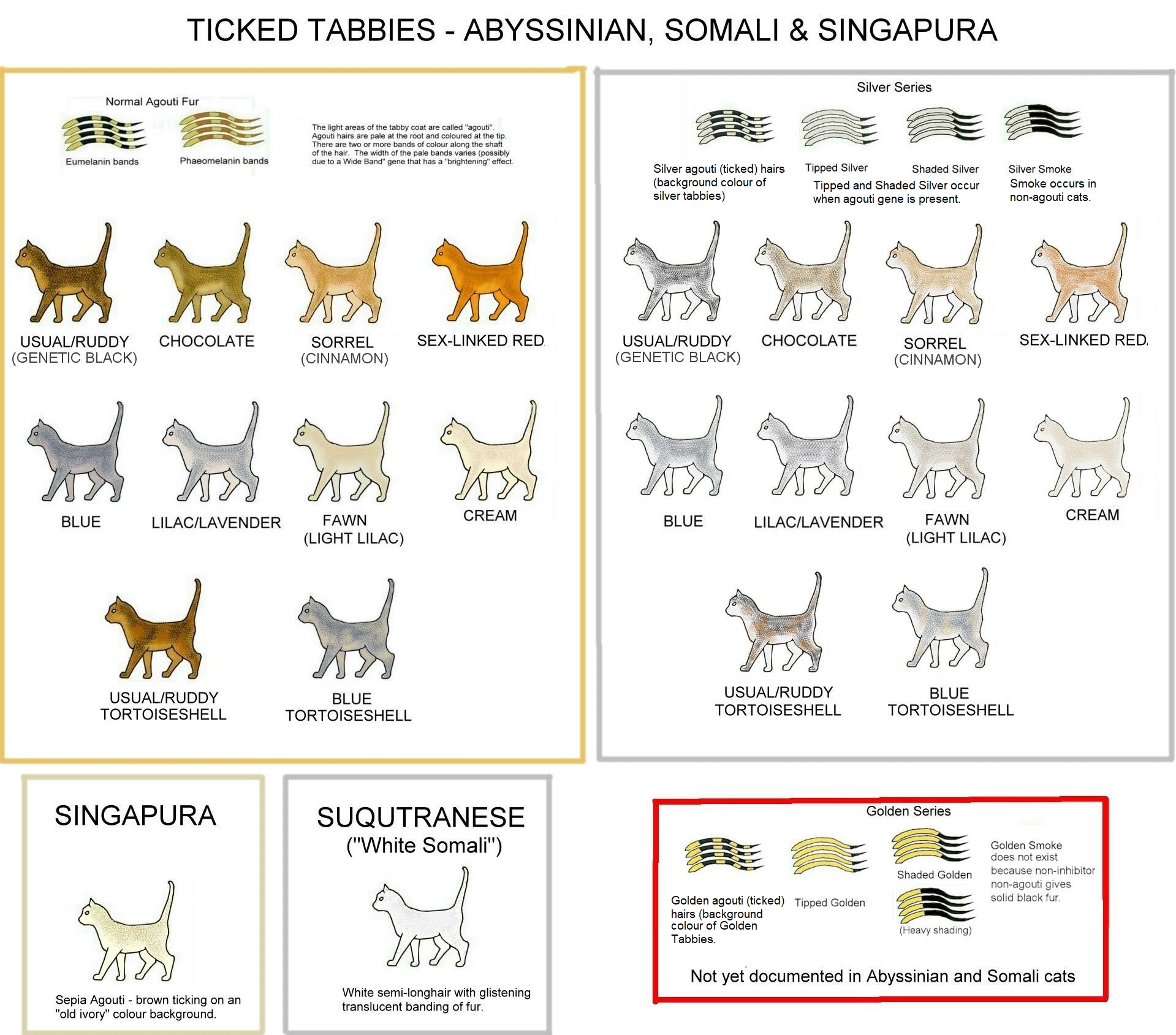
SUQUTRANESE
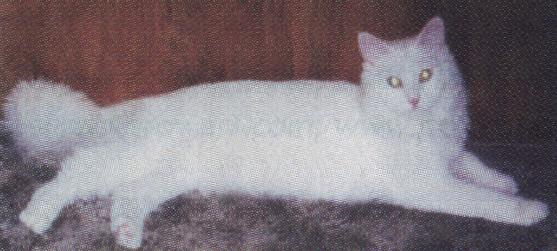 Although superficially solid white, the Suqutranese (Socotranese) is essentially a ticked cat. It is a Somali-type semi longhair with white fur with glistening silver banding. UK registries and Somali breed societies frown upon anyone advertising "White Somalis" so the Suqutranese is not well known. Somali societies distance themselves from the breed. Caroline Garrard and Charles and Betty Barrett were holidaying on the island of Suqutra (a.k.a. Socotra) off the coast of Somalia where they noticed a pure white cat with the conformation and temperament of a Somali. Its white fur had well-defined bands of silvery white clearly visible on the individual hairs. Ms Garrard had a pedigree usual silver Somali male (Clyde) and two white shorthair females. She bred an odd-eyed "White Somali" kitten (Fanny) in 1988 from white queen Fifi Farouche and Clyde. First generation kittens were a mixture of Somali colours and pure whites, mostly semi-longhairs of Somali type. In 1989, Fanny was mated back to her father, producing five White Somali kittens. Fanny s second litter, also in 1989, comprised four White Somalis and one usual silver semi-longhair. Ms Garrard and the Barretts set up a breeding programme to seek recognition for white semi-longhairs of Somali type. They named the breed "Suqutranese" since "White Somali" was unacceptable to registries. Fanny and three of her offspring (2 females and one male) were shown at the CA of Great Britain show in March 1990.
Although superficially solid white, the Suqutranese (Socotranese) is essentially a ticked cat. It is a Somali-type semi longhair with white fur with glistening silver banding. UK registries and Somali breed societies frown upon anyone advertising "White Somalis" so the Suqutranese is not well known. Somali societies distance themselves from the breed. Caroline Garrard and Charles and Betty Barrett were holidaying on the island of Suqutra (a.k.a. Socotra) off the coast of Somalia where they noticed a pure white cat with the conformation and temperament of a Somali. Its white fur had well-defined bands of silvery white clearly visible on the individual hairs. Ms Garrard had a pedigree usual silver Somali male (Clyde) and two white shorthair females. She bred an odd-eyed "White Somali" kitten (Fanny) in 1988 from white queen Fifi Farouche and Clyde. First generation kittens were a mixture of Somali colours and pure whites, mostly semi-longhairs of Somali type. In 1989, Fanny was mated back to her father, producing five White Somali kittens. Fanny s second litter, also in 1989, comprised four White Somalis and one usual silver semi-longhair. Ms Garrard and the Barretts set up a breeding programme to seek recognition for white semi-longhairs of Somali type. They named the breed "Suqutranese" since "White Somali" was unacceptable to registries. Fanny and three of her offspring (2 females and one male) were shown at the CA of Great Britain show in March 1990.
The Suqutranese standard is nearly identical to that of the Somali except the coat must be completely white with silver-white ticking and the nose-leather and paw-pads to be pink. The breeders were hopeful that approval for the breed would be granted by the Cat Association of Great Britain. However, in August 1995 the Somali Cat Breed Advisory Committee took offence at advertisement in various publications for "so-called White Somalis" and issued a statement that Somalis are cats with ticked coats i.e. each hair has several alternating bands of two colours. Any cat with a coat of only one colour is not a Somali and should not be described or sold as such. Since the Suqutranese has a silvery ticked coat and has its own breed name (White Somali being a descriptive term only), this seemed to be a breed society concerned about purity of coloured Somalis. Since then, nothing has been heard of the Suqutranese which is a great pity. A number of Somali breeders overseas have shown interest in re-creating the Suqutranese and it would make a glamourous new addition to the showbench. It would also not be too difficult to reproduce the results (under a less political cat registry) by using a silver Somali male on suitable white females.
Note: In a near parallel of this, during the mid/late 1990s a Somali breeder experimentally crossed Somalis with black shorthairs to create a cat of Somali type but with black fur with a distinct "shimmer". In the early days of Abyssinian breeding, a solid black female called Nigra was produced and was bred fro.
SPOTTED TABBIES
The fourth type of tabby is the spotted tabby. In some mackerel tabbies, the stripes have a natural tendency to break up to form bars or vertically aligned spots. At first it was suggested that the spotted tabby was simply another mutation of the same gene which caused ticked, mackerel and classic tabby. Spotted tabbies were therefore "broken tabbies". In 2009, more research was done and showed that a separate modifier gene is responsible for turning stripes into spots although the location of the gene hasn't been determined.
|
|
|
|
There are a number of spotted breeds in existence. The oldest recognised is probably the Spotted British Shorthair. British Shorthairs have been recognised since the 1870s while American Shorthairs have been recognised (as "Domestic Shorthairs") since the 1900s. The Egyptian Mau may be older, but was not recognised as a breed until the 1950s. The British and American Shorthairs and the Egyptian Mau are naturally occurring breeds which have been refined by selective breeding. In 1872, Dr Gordon Stables described the classes at cat shows at the Crystal Palace and at Birmingham. He wrote "Class VII is for Spotted Tabby [...] A broad black band ran along his back and down his fine tail; and, diverging from this band came dark stripes of colour down the sides, converging round the thighs, and swirling round his chest in two Lord mayor's chains; but the stripes had this peculiarity, they were all broken up into spots."
The Egyptian Mau is sometimes claimed to be the oldest or only naturally occurring spotted breed. This, however, overlooks the Bahraini Dilmun Cat, a spotted variety which is barely known in its own country, let alone internationally. It is also in danger of being lost due to breeding with abandoned Persian cats in Bahrain (Persians ar popular pets, but once the novelty wears off they are frequently turned out to fend for themselves). Dilmun cats are semi-foreign in conformation and have evolved to survive in Bahrain's extremely high summer temperature. Only recently has there been any interest in maintaining this as a breed. It is being bred by the Cat Club of Bahrain and few a Dilmun Cats have apparently reached America.
|
|
|
|
|
|
The Ocicat (1964) and was derived from crossing Siamese with Abyssinian cats to create a ticked-point Siamese. The ocelot-like spotted cat was an attractive surprise result. The Spotted Mist (1976) arose originally from a Burmese/Abyssinian mating and again, the creation of a spotted variety was accidental. The addition of domestic tabby shorthairs refined the type and the pattern and some Spotted Mists show a tendency to a rosetted pattern.
The California Spangled Cat was an early "designer breed" bred in the 1980s to resemble spotted wild cats, but without hybridisation with wild species. The body is spotted and lower legs are striped. A "King Spangled" version had marbled markings like a King Cheetah. These cats never achieved the popularity of the Bengal or Ocicat. The breed was founded using mainly Abyssinians, American Shorthairs and British Shorthairs. However, there are suspicions that wild blood Cat blood entered the mix when breeder Paul Casey acquired a Jungle Cat and also purchased two whole litters of Asian Leopard Cat/Siamese crosses (from old-style Siamese) from a their breeder in Hollywood. The breed had a high profile launch in the 1980s and though still listed by TICA it has almost disappeared.
The Kanaani (Canaan Cat) being developed in Germany is being bred to resemble the spotted wildcat subspecies Felis lybica gordonii, but with domestic temperament. Early photographs suggest an Oriental-type or Ocicat-type spotted breed.
Those were the "first four" of the non-hybrid spotted cats - Spotted Shorthair, Egyptian Mau, Ocicat, Australian Mist (six non-hybrid spotted breeds when the Bahraini Dilmun and Kanaani are counted). There are also spotted breeds where the pattern has been inherited from a wild species of small cat which has been interbred with domestic cats.
The Ussuri is a natural breed of from along the Amur river, Russia. It has reputedly crossed with small wild cats in the area - "Amur Forest Cats" or "Amur Leopard Cats" (Asian Leopard cat subspecies) which may make it a hybrid breed. It is a more robust variety which occurs semi-wild and has also interbred with semi-wild cats of Siberian and domestic shorthair type. The pattern is said to be distinctive - vertical solid or merged spots, which may have been inherited from the wildcat. Whether it is a hybrid is not proven.
|
|
|
In 1963 the Bengal was developed from crossing domestic cats with the spotted Asian Leopard Cat. The original intent was to study the Asian Leopard Cat's supposed natural immunity to certain feline diseases and whether this could be transferred to domestic cats. The end result has been an attractive spotted breed that also includes some margay genes from the Bristol breed developed and abandoned around the same time (the Bristol cats are believed to have introduced the best rosette patterns). In the 1980s, the Geoffroy's Cat was crossed with domestic cats in order to produce the Safari breed with the wild-type rosetted pattern seen in big cats such as leopards and jaguars. Since then. Domestic cats have been deliberately crossed with jungle cats (Chausie), servals (Savannah, Ashera) and fishing cats (Viverral, Machbagral) in attempts to create wild-looking spotted breeds of domestic cat. In Belgium, Bengals have been crossed to the Indian Desert Cat (F lybica subspecies) to create the Punjabi (Punjabi Desert Cat). Punjabis are large, elegant cats resembling the wild parent. The colours are grey-black low contrast spots on ticked ivory to chocolate spots on ticked sandy colour. The spots are randomly aligned and low contrast like the wild parent.
The Mojave Spotted (formerly Hemingway Spotted) is a breed being developed from Bengal x Polydactyl crosses.
|
|
|
Mojave Spotted (formerly Hemingway Spotted): Developed from Bengal x Polydactyl crosses. |
MARBLED TABBIES
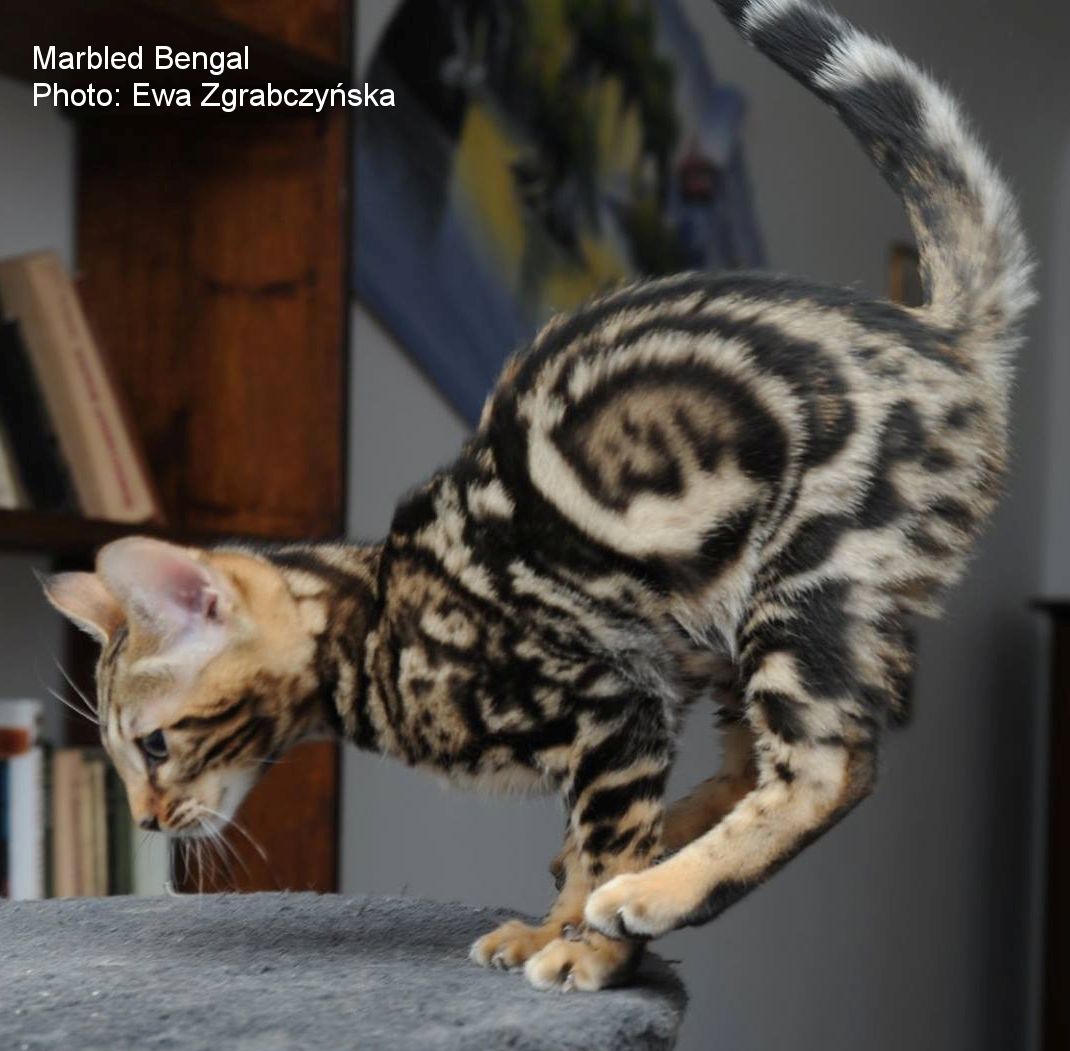
The marbled or clouded pattern is thought to be a variation of the classic tabby pattern. It's a term given to the horizontally aligned swirling of the tabby pattern in certain breeds. The centre of the dark markings contain areas of agouti i.e. the markings are "hollow" or "outlined." This type of pattern occurs in the "Marbled Mist", the marbled variety of Australian Mist (derived from Burmese, Abyssinians and domestic tabbies). Marbled also occurs in a different form in the Bengal (above) through the interaction of wild-type spotting (from the Leopard Cat ancestor) and domestic-type classic tabby. Marbled patterns may be found in other wild/domestic hybrids as more and more of these are developed. The marbled tabby pattern is occasionally been seen in cats with no known Bengal (or other wild-type) ancestry. Other breeds have chosen different terms for this pattern - in the Highland Lynx breed, the marbled tabby pattern is known as "clouded leopard". In some countries with a long indoor/outdoor tradition of cat-keeping, the random-bred population contains a hotch-potch of genes that can come together to create similar patterns.
The Sokoke is a natural breed found in the Sokoke Forest area of Kenya. It is now being developed in Denmark. The pattern of the Sokoke is a modified form of classic tabby peculiar to that breed. Agouti (ticked) hairs appear in the centre of the blotched markings to create "hollow" tabby markings.
FRECKLED, SPECKLED AND SERVALINE-PATTERNED CATS
|
|
|
While the distinct spots found on Egyptian Mau, Ocicat and several other breeds are due to a spotted modifier gene acting on mackerel tabby, there is evidently more to learn about spotted patterns in cats. For example this India street cat (submitted by Vasilis Lekka) shows a distinct "freckled pattern" of very small spots. A small spot pattern is also showing up in some Savannah cats and may be due to a gene found in the Serval species (one of the parent species of the Savannah breed) which produces the "Servaline" pattern. The Poljun also includes the servaline pattern. The Poljum was derived from a Chausie x Bengal cross, originally called "Jungle" and renamed Poljun in 2014. The first kittens Poljun were bred accidentally by Ewa Zgrabczynska, a breeder of Bengals and Chausies; a young male marbled Bengal taught himself to open a door when Ewa was absent and mated a Chausie female. Both cats had excellent, friendly temperaments and the resulting litter had a mix of marbled and ticked kittens.
|
|
No doubt there is much more to be discovered about the striped, spotted and marbled patterns with the introduction of genes from the African serval, the Jungle cat, Geoffroy's Cat and the Fishing Cat into the genetic melting pot.
COLLOQUIAL TERMS: PASTEL TABBIES, MIST TABBIES AND SIAMESE "BREAKTHROUGH" TABBY PATTERNS
These are all colloquial tems rather than cat fancy terms. These are variations on the tabby theme that can be seen in random-bred populations. Pastel tabby is a colloquial term for blue cream tortie tabbies where the tabby pattern is overlaid on a brindled tortoiseshell (the blue and cream hairs are intermixed) giving a hazy effect as shown below.
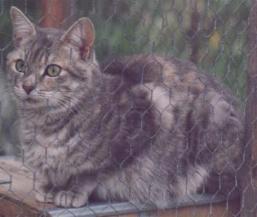
Cats born of Siamese parents sometimes have a tabby/spotted pattern breaking through so strongly that the cat appears to be a tabby/spotted Oriental or a tabby/spotted sepia (Burmese) pattern. Viewed closely, the pattern colour is heavily ticked on a paler ticked background. This breakthrough pattern is evident from kittenhood and not the same as age-related darkening in Colourpoint cats. It is inherited, possibly due to modifier genes that prevent the colourpoint gene from properly inhibiting the colour/pattern on the normally pale areas of the body. A similar effected of dark ticked markings on pale ticked bckground is found in the Australian Mist breed.
A stongly marked seal-tabby Siamese with a breakthrough spotted pattern (looked like a Spotted Tabby Oriental with blue eyes) mated to a Siamese produced a litter containing one strongly marked classic tabby that looked more like a Classic Tabby Oriental with blue eyes. The breakthrough pattern has become a problem in some Australian lines. Another example was a lynx-point Siamese female (old-style conformation) in England that looked like a slightly washed out tabby with blue eyes. Her colour raised questions as to whether she was genuinely colourpoint or was genetically mink or sepia pattern from Tonkinese lines.
AMBER TABBIES
Amber is a colour peculiar to Norwegian Forest Cats caused by a black modifier gene. It was discovered during the 1990s and initially thought to be due to the genes for chocolate, lilac, cinnamon or fawn; these genes are not permissible in the breed as they indicate outcrossing to other breeds. Some cats were registered as goldens. Testing matings with chocolate point Birmans and between the so-called "x-colour" cats demonstrated it to be a new colour (due to a black modifier gene). The two new colours are called Amber and Light Amber; amber is a modifed form of black and light amber is a modified form of blue. Kittens are born dark and undergo a period of extreme brightening of the black/blue areas as they mature. Their original birth colour is often seen only on the back and tail, allowing amber and light amber to be distinguished from one another.
Amber is apricot-to-cinnamon colour with brown paw pads, nose leather and eye rims. Kittens are born dark or black, with ghost markings (resembling poor quality silver tabbies), and brighten as they mature. Light Amber is a pale beige colour. Kittens are born blue and brighten with age, becoming pink-beige to fawn at maturity. The nose leather, eye rims and paw pads are dark blue grey. Amber Tabbies are born apricot with black markings; the markings brighten to reddish-brown/cinnamon at maturity. The nose is pink and the paw pads and eye rims are brown. Light Amber Tabbies are born beige with blue tabby markings; the markings brighten to pink-beige/fawn at maturity. The nose is pink and the eye rims and paw pads are blue-grey. Amber/light amber replaces black/blue in torties/tabby-torties.
THE GENETICS OF SILVER TABBIES AND GOLDEN TABBIES
Silver tabby is caused by the presence of the dominant Inhibitor gene. Silver tabbies have a silvery background colour with a tabby pattern overlaid on it. Silver tabbies in the random breeding population are prone to tarnishing - the appearance of a yellowish or rusty hue. The Inhibitor gene seems eliminate the yellow pigment in the ticked hairs of the background colour, but does not affect the solid coloured areas (the markings).
|
|
|
|
The best known silver tabbies are those with black markings as shown on this page. Silver tabbies with other colour markings also occur e.g. Blue Silver Tabby, Chocolate Silver Tabby, Lilac Silver Tabby, Cinnamon Silver Tabby, Fawn Silver Tabby, Red Silver Tabby (Cameo Tabbies) and Cream Silver Tabby (Cream Cameo Tabbies).
The Inhibitor gene has also been introduced into Abyssinians and Somalis to create silver-undercoated varieties of ticked tabby. The Golden Tabbies have a brighter more golden background colour gained from inheriting the recessive form of the Inhibitor gene from Chinchilla parents. The Inhibitor gene causes silver tabbies, but since most genes occur in pairs the Inhibitor gene has a partner gene, sometimes referred to as "non-Inhibitor". It has been suggested that the brighter background colour of Golden tabbies is due to a "Wide Band" gene which determine the width of the hair shaft colour between the pigmented tip and the follicle. Golden Shadeds lack the dominant Inhibitor gene, but have a shading pattern comparable to Silver Shaded cats. It's likely that there are polygenes that affect the undercoat width.
The Inhibitor gene is more effective at blocking black-based pigment than blocking red-based pigment, hence there may be a breakthrough of reddish colour known as "tarnishing". Tarnishing is common on the muzzles of random bred silver tabbies, but rare on pedigree silver tabbies due to selective breeding and refinement.
GENETICS OF TAQPEP (TABBY PATTERN DEVELOPMENT) AND SOME OLDER THEORIES ABOUT TABBY PATTERNS
GENETICS OF AGOUTI AND CORIN GENES - HOW HAIRS GET THEIR TICKING